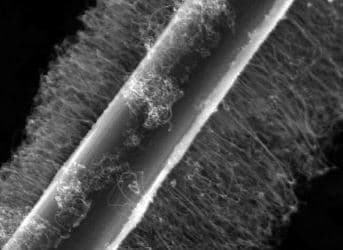The other day I was musing over how materials throughout history have improved our lives. Take the ordinary candle, which is made of beeswax. It helped us overcome our fear of the dark. The candle provided a totally new capability: People had a portable light source to allow them to see and read anywhere they wanted.
Today we have hand-held devices that not only enable us to read anywhere we want, but also access reading material anywhere it is available in the world. We owe this revolution to ordinary beach sand, which is a source of silicon that makes digital circuits work.
And the remarkable materials of history do not end here. For example, common corn provides the basis for biodegradable plastics, shrimp shells in powder form can help us control our cholesterol, and we have even invented flexible concrete that widens its application. Materials are fundamental to revolutions that improve our lives.
A new emerging class of materials, carbon composites, is revolutionizing the performance of mobile platforms. Carbon fibers, which are thin and flexible like ordinary sewing thread, can dramatically reduce weight and therefore vehicle fuel consumption, but at the same time provide greater safety because of their toughness. Defense systems, like the Predator Unmanned Air Vehicle, pioneered the path to exploiting these materials. The X43 scram jet at nearly 10 times the speed of sound set the world airspeed record through the use of carbon composites. We are now seeing the emergence of these materials in the Boeing Dreamliner and automobiles like the Chevy Corvette.
Quite remarkably, you can form a new ceramic material from combining beach sand and carbon like that contained in soot. As the ancients understood, ceramics can withstand very high temperatures because they do not melt like metals. There are many advantages to high-temperature, high-strength materials:
• They enable the Space Shuttle to withstand intense heat loading upon reentry in the atmosphere. • They are the basis of ceramic brakes that resist wear, even at very high temperatures where metals fatigue. • They can also improve engine efficiency. With a properly chosen medium, you can store large amounts of high-temperature heat. You can then use that high-energy medium to drive mechanical devices, like turbines, to produce high-speed motion, and with it electricity at high-efficiency.
One such ceramic material, silicon carbide, can withstand temperatures of over 2,000 degrees Centigrade without loss of strength; metals exhibit fatigue at 700 degrees Centigrade. Its properties suggest some important safety applications, such as replacing the metal tubing that surrounds nuclear fuel in light water reactors.
Silicon carbide can also withstand the intense neutron environment in a nuclear reactor over long periods of time, because it has the remarkable property of self-healing. It repairs itself like living cells.
These properties have inspired engineers at General Atomics to develop a new nuclear reactor concept with potentially far-reaching performance advantages. This reactor, Energy Multiplier Module (EM squared), is the smallest-size, highest-efficiency and highest-power small modular reactor in the world. Because the fuel surrounded by silicon carbide tubing can withstand high temperatures (more than 2 ½ times that of current reactors) and transfer its heat to a high-capacity medium, like helium, the reactor system can achieve 53 percent efficiency, which is nearly twice that of other small modular reactors.
Since the fuel contained by the silicon carbide tubing can stay in the reactor for longer periods of time (nearly seven separate fuel loadings of current reactors), there is much less waste; in fact, 80 percent less waste. And because the fuel and silicon carbide can withstand much higher temperatures, the safety margins are potentially much better.
Like any new technology that can dramatically improve performance, there are economic benefits. We can reduce the price of electricity by 40 percent relative to current reactors. This puts the price of nuclear-generated electricity within the energy mix in the United States. It also makes such reactors much more competitive in international markets.
This innovation comes at a time when nuclear energy has reached a crossroads. So we have a choice: Embrace new technology, as we have in the past, to improve performance, or continue to look in the rear-view mirror with ideas that just hold back human progress.
By John Parmentola
John Parmentola is the senior vice president for energy at General Atomics, responsible for the strategic direction and day to day operations of the San Diego-based company’s Energy Operating Group. He oversees a team of nearly 475 scientific and technical staff, from over 90 institutions worldwide, who lead the way in international nuclear fusion and fission research and development.


















